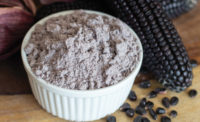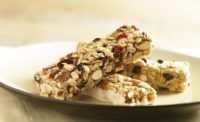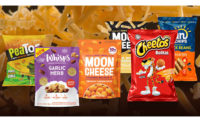Some snack categories today are tough to crack. According to data from IRI, Chicago, dollar sales in the crackers category during the 52 weeks ending September 4, 2016 rose 0.98 percent to reach $7.4 billion. Stagnant sales plagued several top companies, including Mondelez International (up 0.55 percent), Kellogg Co. (down 2.00 percent) and Stacy’s Pita Chip Company (down 1.74 percent).
Crackers with fillings faced the same conditions, with dollar sales rising 0.40 percent to reach a market share of $1.1 billion; same goes for graham crackers, up 1.53 percent to reach $453.6 million.
But select leaders in the cracker category had more-promising news. Sunshine Biscuits, maker of Cheez-Its, was up 5.37 percent to $917.6 million, and Pepperidge Farm saw dollar sales increase by 5.38 percent to 807.5 million.
“The overall market for crackers has been relatively low growth,” says Brian Blanchard, vice president of kid snacking and innovation and expansion, Pepperidge Farm, Norwalk, CT. “Growth in the market has been challenged because of shifting consumer tastes that have left many cracker brands struggling to maintain relevance with consumers.”
Clearly, some cracker producers are starting to grab more market share. The Mondelez brand Nabisco saw dollar sales rise 18.50 percent for its Ritz Fresh Stacks to $148.2 million. Also, Cheez-Its Grooves from Sunshine Biscuits were up 15.92 percent to $85.1 million. In the “with fillings” segment, Nabisco Ritz filled crackers were up 18.95 percent to $109.8 million, and Snyder’s-Lance brand Lance Toast Chee crackers were up 17.84 percent to $97.0 million; multiple Lance filled cracker products saw notable gains over the reporting period. In 2015, Lance added several new flavors to its Quick Starts Breakfast Biscuit Sandwiches.
Gluten-free is also still attracting attention. Crunchmaster saw some success with its products over the reporting period, up 6.91 in dollar sales to $51.4 million. It offers popped and other gluten-free chips made with edamame, ancient grains, sesame seeds, flax seeds, amaranth and quinoa.
Select trends are helping some cracker brands prepare for growth going forward—and aren’t experiencing growing pains of dipping sales while they reinvent themselves to meet shifting consumer demands.
And, what are those demands? “Transparency, nutrition and flavor,” says Genelle Chetcuti, senior director of marketing, RW Garcia, San Jose, CA.
If you ask Chetcuti, brands have to check all the boxes: transparency, communicating product origins and company practices; a clean label and better-for-you characteristics, complete with third-party certifications; and—perhaps most of all—offerings must be delicious. Gone are the days when health-conscious consumers will compromise on taste.
“At the end of the day, everyone wants a product that tastes great and satiates their snack needs,” Chetcuti says, “so brands need to be focused on innovation and getting ahead of the next trendy ingredient or flavor.”
Better-for-you is baseline
Better-for-you branding and ingredient panels are no longer optional for cracker brands. In order to compete, snack producers must offer some products with either a clean label highlighting recognizable ingredients or nutrient-dense ingredients that boast a health benefit—or both.
“Consumers are demanding more transparency—in terms of a food’s source and origin, as well as processing and labeling—and clean, simple label options,” explains Courtney Schwartz, senior marketing communications manager of food technologies, Kemin, Des Moines, IA. “This renewed label awareness is fed by consumers’ concerns over preservatives and the importance of knowing where their food is coming from.” To that end, Kemin recently launched an oil-soluble green tea extract that can replace synthetic antioxidants and tocopherols in formulations. And, she notes, it meets clean-label demands while providing cost savings.
When it comes to sweetness, says Catherine Barry, director of marketing, National Honey Board, Firestone, CO, manufacturers have a clean-label, easily recognizable ingredient in honey. “The all-natural sweetener has a positive perception from consumers and, since it is made in nature, satisfies clean-label demands,” she says. “Honey is also familiar, which can’t be underestimated when used in a new product.”
This speaks to yet another trend when it comes to clean label, which is a shift away from ideas like low-fat or 100-calorie packs, says Blanchard. “It’s much more about real and simple ingredients and minimal processing,” he adds, noting that low-fat and low-calorie have fallen out of favor because of the “perception that artificial ingredients and heavy processing are required to achieve them.”
At Pepperidge Farm, this takes the shape of cleaning up the label with USDA organic certifications and a heavy focus on that change when it comes to marketing and advertising. Made with Organic Wheat Goldfish check this box, but all Goldfish packaging now emphasizes the clean label elements that have always been a part of the product, like 100 percent real cheese, no artificial flavors or preservatives, and/or colors sourced from plants.
Clean label is also taking center stage at Mondelez. One example is the GOOD THiNS brand of products, which was “created in response to consumers’ desire for delicious snacks that start with real ingredients—like wheat, potato and rice—combined with enticing flavors, like spinach, garlic and sweet potato, baked thin and crispy,” says Richard D. Buino, corporate communications. New White Cheddar, Sea Salt, and Sweet Oat and Flax varieties launched in summer 2016 join such varieties as Veggie Blend and Garlic and Herb.
Still, other cracker brands are differentiating themselves by not just cleaning up their labels, but by beefing up that label with nutrient-dense ingredients.
At ADM, Chicago, this takes the shape of bean ingredients and ancient grains. “Beans are non-GMO and gluten-free and, because ADM VegeFull bean ingredients are whole, cooked beans, they provide both high protein and fiber,” says Janice Rueda, Ph.D., director of research and business development. “The combination of bean ingredients like chickpeas or black beans with specialty grains like quinoa and teff can increase the nutritional profile of the snack, while also supporting a brand’s health and eco-friendly messages.”
Vegetables, grains, seeds and beans are popping up in crackers, notes Chetcuti. At RW Garcia, varieties are made with a base of non-GMO corn and then boosted with antioxidant-, fiber- and protein-rich ingredients like flax, chia and black sesame seeds.
“Flavor and better-for-you options are driving trends in the cracker aisle,” says Barry. “The major brands still control a massive share of the cracker market and are bringing innovation to the aisle through line extensions with unique flavor pairings, such as sweet-and-heat or sweet-and-spicy.” Honey pairs well with herbs and spices that can elevate any cracker’s flavor profile, she adds.
For Rueda, this reinvention that marries better-for-you with out-of-this-world flavor is the future. “Crackers are a mainstay of American snacking, but there is some really exciting expansion potential in the category: crackers reinvented,” she says. “One big opportunity lies in creating innovative uses for crackers within the snacking context, making them more of a main event than their more traditional supporting role.”
The way to do that? Clean up labels by removing anything unrecognizable and beef-up nutrient density with nuts, seeds and vegetables—and ensure delicious flavor. The result will be an elevated cracker that can stand on its own taste-wise and nutrient-wise.
Pack it up
Packaging plays a vital role in whether a product can catch the eye of a consumer. In this crowded, competitive cracker market, emerging packaging trends can help build cracker brands that stand out on the shelf.
Trend watch: Wayne Slaton, senior director of sales, Douglas Machine Inc., Alexandria, MN, sees a shift toward flexible and stand-up pouches, as opposed to the conventional bag-in-box packaging.
Product watch: Douglas has invested heavily in flexible pouch handling for RSC, RRP and aisle displays. Its TriVex line of top-loading corrugated packaging equipment can output both stand-up and lay-flat packaging designs.
Trend watch: At Bosch Packaging, New Richmond, WI, Product Manager Kelly Meer is noticing an opportunity for crackers to play a part in the snack-as-meal trend.
Product watch: Bosch launched the first modular system that can package crackers on edge at IBIE and PACK EXPO in 2016, which consists of a loader, transfer unit, feeder, horizontal flow wrapper and endload cartoner. The result? A system that can “handle rectangular, square, round and sandwich products at higher speeds,” Meer says.







